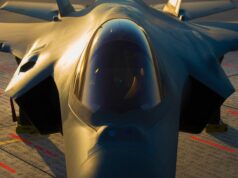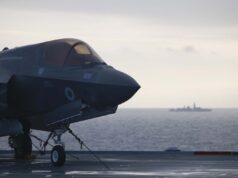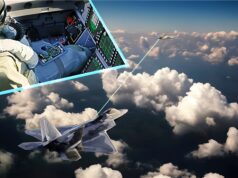Leonardo has introduced its largest-ever Remotely-Piloted Air System (RPAS), the Falco Xplorer.
Building on the Falco family of tactical-class RPAS, the new drone features a payload capacity of 350kg, more than 24 hours flight time and a satellite communications capability for beyond-radio-line-of-sight operations, all within a 1.3 ton maximum take-off weight.

“Everything is designed in-house by Leonardo, from the aircraft itself to the sensor suite, mission system and ground control station and the Falco Xplorer will be offered as both an integrated platform and as a fully-managed information-superiority service. In the latter model, Leonardo will operate the aircraft and its sensors and manage logistics to provide actionable information directly to the customer.”
This is similar to how Elbit operate their maritime patrol aircraft service with unmanned aircraft, more can be found on that here.
“Leonardo invests continuously in new capabilities to ensure we position the right products in the right markets”, said Leonardo CEO Alessandro Profumo, who presented the Falco Xplorer at its unveiling.
“The Falco Xplorer is designed to be extremely competitive in its category, building on the experience we’ve gained working with Falco family customers over a number of years and our Company’s strengths in the unmanned domain. By understanding and being able to meet our customers’ needs, we expect to increase our share of the unmanned systems market.”
The new drone is expected to embark on its maiden flight in June from Trapani Airport in Italy. The firm say that a series of trials will then take place throughout the year, capped off by a flight campaign with the platform’s fully-integrated sensor suite on-board.













I though large unmanned drones weren’t allowed to fly in European airspace.
They are, they just need certain safety features such as sense-and-avoid and lightning protection. The MQ9A Predator doesn’t have these features currently (or the NATO-required ones), so they can only be used in restricted airspace, so the only place we can really use them is in theatre or in the massive weapons ranges the US has.
Most of the RPAS operated in Europe are MQ9As.
Certifiable Predator B, or the MQ9B (aka Protector) will have these features, and will be certified for use in UK/European airspace (hence the certifiable bit), so we’ll be able to fly them anywhere the military could fly a manned aircraft.
Got to give Leonardo its due, it at least has the balls to release new aircraft. BAe Systems lost that mojo a long time ago – plenty of research work at the tax payers expense but that’s it.
Not sure how it compares to the Euro MALE RPAS in terms of performance, but it seems that Leonardo have a serious contender that is ITAR free, which gives it great export opportunities as well as a single engine design which is cheaper maintenance than the twin engined Euro MALE RPAS.
After doing a bit of reading seems this drone is comparable to Sagem Patroler weighing about a ton, and nothing comparable to the predator which is 4+ tons and the Euro MALE at 10+ tons!
Yep. Not sure what market this is aimed at. Euromale and Reaper have the European market sewn up for the larger end. As for export sales it looks like some of the middle eastern states that had a dalliance with Chinese drones are suffering from a case of buyers remorse. The Jordanians have put there’s up for sale after a couple of years. Apparently the US is looking like it will allow Reaper sales there.
But what is really regrettable is that the UK didn’t go for Mantis. BAE had a good product there. It was only the UK’s desperation for a solution for Afghanistan that led us to Reaper. The 2 engines in particular was a smart move as a significant number of UAV losses are due to engine failure.
Its hard to keep up with the pace technological development of the US offerings to remain competitive with exports. In the US competition between the big companies ensures they are at the cutting edge and always pushing forward. When it comes to UK defense projects it feels like it starts cutting edge but doesn’t move forward 1mm over the 15 years it actually takes to deliver it unless you scrap the project and start all over again.